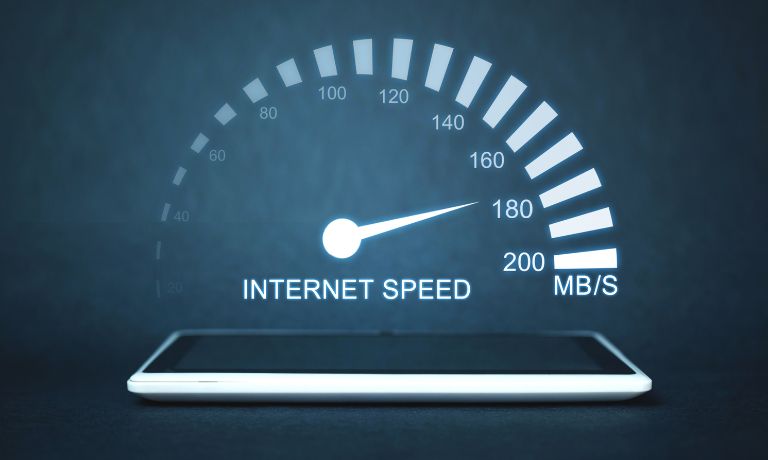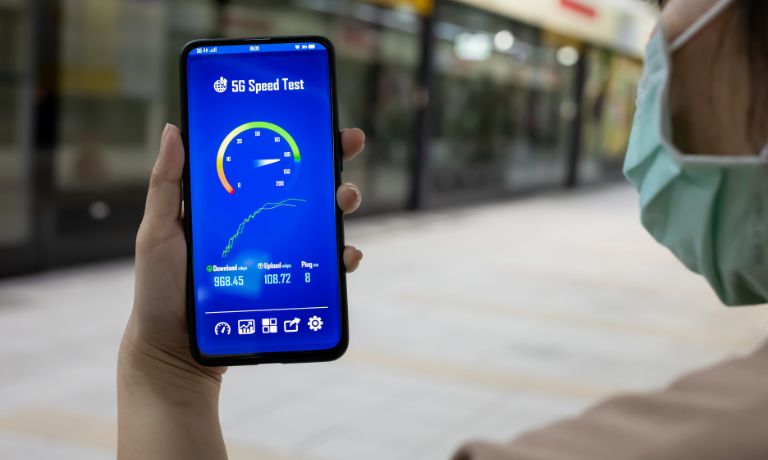Many people wonder what a good internet speed is for their daily needs. You might notice that some websites load slowly, videos buffer, or video calls freeze — even if you’re paying for “fast” internet.
The truth is, what counts as “good” internet speed depends on how you use the internet, how many people share your network, and the quality of your Wi-Fi setup. In this guide, you’ll learn how to check your speed, what speed you really need, and how to upgrade if your current connection isn’t cutting it.
What Is Internet Speed? Basic Terms Explained

When you buy internet service, your provider usually advertises speeds like 100 Mbps or 500 Mbps. Mbps stands for megabits per second. This measures how much data your internet can transfer every second. The higher the Mbps, the faster your connection should feel.
You should know about two important speeds: download speed and upload speed. Download speed affects how fast web pages, videos, and files load on your device. Upload speed affects how fast you can send data to the internet — for example, when you upload videos, send large email attachments, or participate in video calls.
Another key factor is latency, also called ping. This is the delay in communication between your device and the internet, measured in milliseconds. Lower latency means faster response times, which is especially important for online gaming and video conferencing.
If your download and upload speeds are fast, and your latency is low, your internet experience will feel smooth and responsive.
What Is a Good Internet Speed for Common Activities?
Different activities require different internet speeds. Here’s what you should aim for:
Streaming video:
- SD (Standard Definition): 3–5 Mbps per device
- HD (High Definition 1080p): 5–10 Mbps per device
- 4K (Ultra HD): 25 Mbps or more per device
If you have a family watching 4K Netflix while others browse or stream, you’ll need a higher total speed.
Online gaming:
- 15–25 Mbps download is plenty for most games.
- What matters more is latency — lower than 50ms is great. Lower latency reduces lag.
Video calls (Zoom, Microsoft Teams, Google Meet):
- 3–5 Mbps upload and download per active call.
- If multiple people are doing video calls at the same time, you’ll need more bandwidth.
Web browsing and social media:
- 5–10 Mbps per user is more than enough for basic browsing, emails, and apps.
Multiple users and devices:
- Add roughly 10–20 Mbps for each extra person or active device in your household.
- Smart TVs, security cameras, and smart home devices also use bandwidth.
Using a simple bandwidth calculator helps you add up all your devices and activities at once, so you know exactly how much speed you really need for everything to run smoothly.
Summary: If you live alone and browse or stream HD, 50–100 Mbps is great. For a family of 4 with multiple devices, aim for 200 Mbps or more to avoid slowdowns.
How to Test Your Current Internet Speed?
Before you decide to upgrade your internet, it helps to know what speed you are actually getting. Testing your speed is simple. Just visit a site like Speedtest.net or Fast.com. Press the start button, and the site will quickly show your download speed, upload speed, and latency.
It’s a good idea to run the test a few times during the day. Speeds can vary, especially during busy hours when more people are using the network in your area.
Once you know your results, compare them to the recommended speeds for your activities. If your speed is much lower than you expected — or lower than what your internet provider promises — contact your provider to check for possible issues or upgrades. If your speed seems fine but devices still feel slow, your Wi-Fi setup may need attention.
How to Upgrade Your Internet Plan

If your internet speed isn’t enough for your needs, the first option is to upgrade your plan through your internet provider. Many providers now offer fiber internet, which delivers excellent speeds and low latency. If fiber is not available in your area, cable internet is usually the next best option. Cable speeds vary but often go as high as 1000 Mbps.
Before committing to an upgrade, ask your provider about current deals. Many offer promotional rates for new or upgraded plans. You might get a large speed increase for a small additional monthly cost.
It is also important to check your home equipment. If your Wi-Fi router or modem is several years old, it might not handle higher speeds well. In that case, upgrading to a modern router — preferably one that supports Wi-Fi 6 — can help you get the most out of your new internet plan.
How to Improve Your Wi-Fi Setup at Home
Even with a fast internet plan, poor Wi-Fi setup can cause slow speeds and dead spots in your home. Here’s how to get the most out of your connection:
- Place your router in a central location.
Don’t hide it in a closet. Place it in an open, elevated spot to maximize signal coverage. - Use Ethernet for key devices.
Gaming consoles, smart TVs, and work laptops work best with a wired Ethernet connection. This reduces latency and avoids Wi-Fi slowdowns. - Upgrade to a modern router.
If your router is more than 3–5 years old, replace it. Look for a Wi-Fi 6 router for better speed, range, and handling of multiple devices. - Add Wi-Fi extenders or a mesh system.
In large homes, Wi-Fi signal weakens across floors or through walls. A mesh Wi-Fi system or extenders can spread strong signal everywhere. - Limit bandwidth-hogging devices.
Some devices (security cameras, cloud backups) can use a lot of bandwidth. Schedule uploads for off-hours or limit device access if your network feels slow.
In many cases, simply upgrading your router and using a mesh system can make your entire home feel like it has a faster connection — even without changing your internet plan.
Conclusion
A good internet speed depends on what you do online and how many devices share your network. Basic browsing and email need little bandwidth, but streaming, gaming, and video conferencing require more. For a family or heavy internet users, a plan offering 200 Mbps or higher is often the best choice.
Run a speed test to check your current connection. If it’s too slow, upgrading your plan and improving your Wi-Fi setup can make a big difference. With the right speed and a solid home network, your internet experience will be faster, smoother, and more reliable.
I’ve been into SEO and blogging for over 7 years. I help websites show up higher on search engines. I really enjoy writing helpful guides, especially about gaming and tech stuff.
